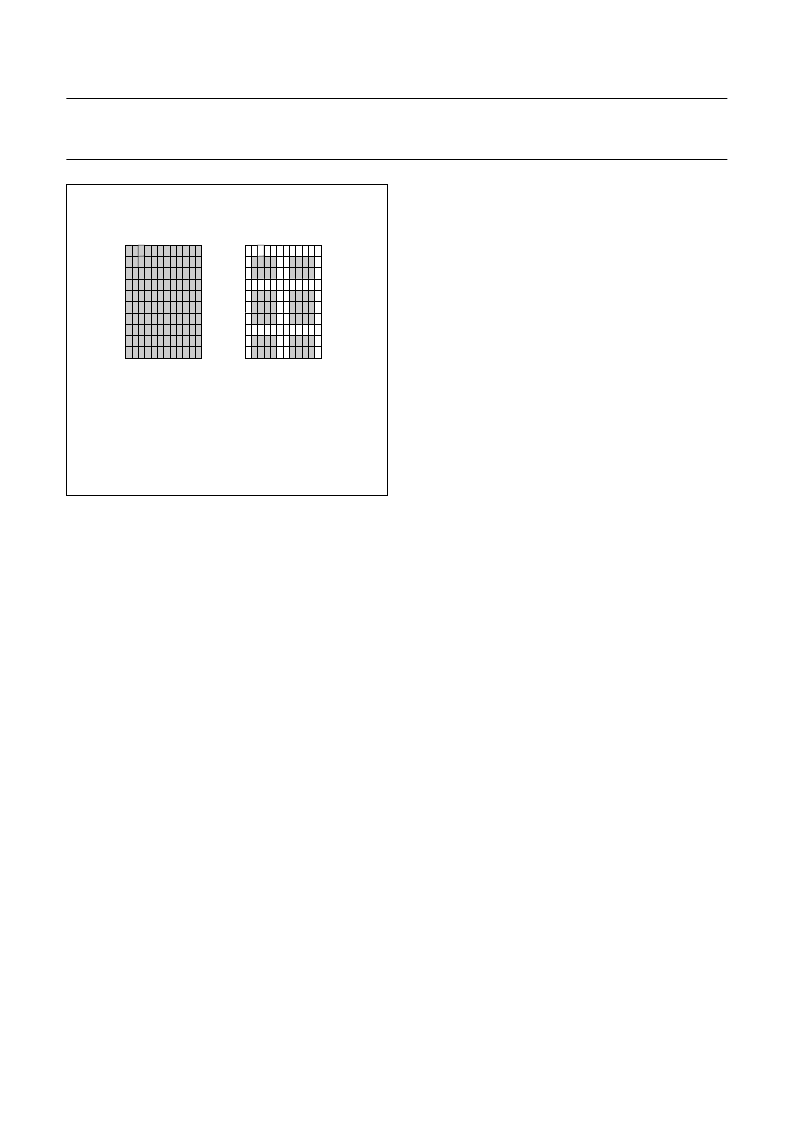- 您現(xiàn)在的位置:買賣IC網(wǎng) > PDF目錄372110 > SAA5496H (NXP Semiconductors N.V.) DPST MINIATURE POWER RELAY PDF資料下載
參數(shù)資料
| 型號: | SAA5496H |
| 廠商: | NXP Semiconductors N.V. |
| 英文描述: | DPST MINIATURE POWER RELAY |
| 中文描述: | 經(jīng)濟圖文電視和電視微控制器 |
| 文件頁數(shù): | 41/68頁 |
| 文件大小: | 612K |
| 代理商: | SAA5496H |
第1頁第2頁第3頁第4頁第5頁第6頁第7頁第8頁第9頁第10頁第11頁第12頁第13頁第14頁第15頁第16頁第17頁第18頁第19頁第20頁第21頁第22頁第23頁第24頁第25頁第26頁第27頁第28頁第29頁第30頁第31頁第32頁第33頁第34頁第35頁第36頁第37頁第38頁第39頁第40頁當前第41頁第42頁第43頁第44頁第45頁第46頁第47頁第48頁第49頁第50頁第51頁第52頁第53頁第54頁第55頁第56頁第57頁第58頁第59頁第60頁第61頁第62頁第63頁第64頁第65頁第66頁第67頁第68頁

1997 Jul 07
41
Philips Semiconductors
Preliminary specification
Economy teletext and TV microcontrollers
SAA5x9x family
9.11
Quadruple width display (SAA549x)
Two successive double width control characters will
invoke quadruple width display. Quad width display is
terminated by another size control character.
Any combination of two of the four controls which invoke
double width display (double width, double size, double
width OSD and double size OSD) can invoke quad width
display. If a double size control character is part of the
sequence, characters will be displayed in quad width and
double height.
To ensure that broadcast teletext pages can be displayed
correctly, quadruple width will only be displayed if the
TXT4.QUAD WIDTH ENABLE bit is set. If this bit is not set,
two successive double width characters will invoke double
width display.
If quadruple width characters are to be used within OSD
boxes (see later section) then the first of the width
characters must be either ‘double width’ (OEH) or ‘double
size’ (OFH).
Fig.12 Contiguous and separated mosaics.
handbook, halfpage
mosaics character 7FH
contiguous
mosaics character 7FH
separated
MGL117
This is because if two consecutive size implying OSD
control characters are used, the first starts the OSD box
and the second finishes the OSD box, and therefore no
OSD box is defined.
Quadruple width characters must not start in columns 37,
38 or 39 of the display since the whole of the character
cannot be displayed.
9.12
Page attributes
Row 25 of the basic page memory contains control data
from the page header of the page stored in the memory.
The bits which affect the display are the newsflash (C5),
subtitle (C6), suppress header (C7), inhibit display (C10)
and language control (C12 to 14) bits.
If either the newsflash or the subtitle bit is set a different
SFR is used to define the display mode, as described in
Section 9.13.
The suppress header bit causes the header row (row 0) to
be displayed as if every character was a space and the
inhibit display bit has this effect on every display row.
The language control bits cause certain character codes to
be interpreted differently, as described above.
9.13
Display modes
The device signals the TVs display circuits to display the
R, G and B outputs of the device, rather than the video
picture, by outputting a logic 1 on the VDS output. The way
in which this signal is switched is controlled by the bits in
the TXT5 and TXT6 SFRs. There are 3 control functions -
text on, background on and picture on. Separate sets of
bits are used inside and outside teletext boxes so that
different display modes can be invoked. Also, different
SFRs are used depending on whether the newsflash (C5)
or subtitle (C6) bits in row 25 of the basic page memory are
set (SFR TXT6) or not (SFR TXT5). This allows the
software to set up the type of display required on
newsflash and subtitle pages (e.g. text inside boxes, TV
picture outside) this will be invoked without any further
software intervention when such a page is acquired.
相關PDF資料 |
PDF描述 |
|---|---|
| SAA5496PS | DPST MINIATURE POWER RELAY |
| SAA5497H | DPST MINIATURE POWER RELAY |
| SAA5497PS | DPST MINIATURE POWER RELAY |
| SAA5X9X | Economy teletext and TV microcontrollers |
| SAA5291APS | IC SW OFF-LINE PS 10/15W 8SMD |
相關代理商/技術參數(shù) |
參數(shù)描述 |
|---|---|
| SAA5496PS | 制造商:PHILIPS 制造商全稱:NXP Semiconductors 功能描述:Economy teletext and TV microcontrollers |
| SAA5497 | 制造商:PHILIPS 制造商全稱:NXP Semiconductors 功能描述:Economy teletext and TV microcontrollers |
| SAA5497H | 制造商:PHILIPS 制造商全稱:NXP Semiconductors 功能描述:Economy teletext and TV microcontrollers |
| SAA5497PS | 制造商:PHILIPS 制造商全稱:NXP Semiconductors 功能描述:Economy teletext and TV microcontrollers |
| SAA5500PS | 制造商:PHILIPS 制造商全稱:NXP Semiconductors 功能描述:Standard TV Microcontrollers with On-Screen Display(OSD) |
發(fā)布緊急采購,3分鐘左右您將得到回復。